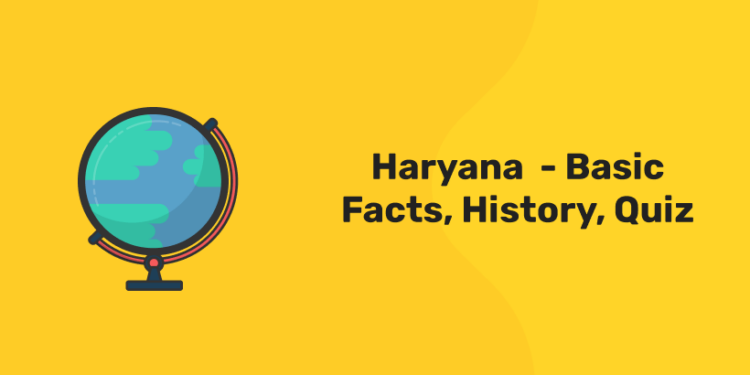Table of Contents
On November 1, 1966, the state of Haryana was formed. It used to belong to the Indian state of Punjab. It takes up 1.3 percent of the country’s total land area. It is bordered on the north by Himachal Pradesh, on the east by Uttrakhand, on the northeast by Rajasthan, on the south by Rajasthan, on the east by Uttar Pradesh and Delhi, and on the northwest by Punjab. The state of Punjab shares its capital, Chandigarh. Gurgaon, Faridabad, Kamal, Panipat, and Kurukshetra are the most populous of Haryana’s 22 districts. There are nine districts in the state that are part of the Delhi National Capital Region, which is one of India’s fastest expanding economic regions.
Haryana was a centre of advanced habitation and a plethora of activity during Vedic culture and the Indus Valley Civilization. Haryana’s official language is Hindi, but the Haryana dialect is spoken in most parts of the state.
History of Haryana
Haryana’s history may be traced back to the Indus Valley Civilisation and the Mahabharata. Many historians believe Haryana’s name is derived from two Sanskrit words: Hari (God) and Aranya (Land) (forest). Rakhigarhi, a village in the state’s Hisar district, is a more than 5000-year-old site that has been discovered with a drainage system, paved roads, and clay figurines, indicating the presence of the Indus Valley Civilisation.Historians believe that the evidence uncovered in Rakhigarhi village strongly suggests that the Ghaggar Basin is the location where the Indus Valley Civilization allegedly began and eventually extended throughout the Indus Valley. The Indus Valley Civilization may also be found in Mitathal and Banawali, both of which are located in Haryana.
Various evidences also suggest that the Vedic civilisation was founded on the banks of the Saraswati River in Haryana. Krukshetra was also the site of the Mahabharata’s epic battle, as well as three other conflicts in Panipat, which are thought to have determined India’s current future. Haryana is known in Indian mythology as Brahmavart, the location where Hindu religion and social order flourished and expanded throughout India. As a result, many of the Hindu religion’s and society’s ideals and structures were developed in Haryana’s partly flat, partly hilly terrain.Kuruskshetra was also the site of the violent battle between Kaurava and Pandava in the Mahabharata, and it was during this war that Lord Krishna delivered a celestial lecture that became the most hallowed scriptures of Hindu religion.
In the mediaeval time, Delhi was a valuable possession, and Haryana functioned as an entry point to it due to its location and proximity to Delhi. Invaders and crusaders from all over the world rushed into Haryana, resulting in fierce wars that altered India’s history. Timur Lang stormed Delhi with the support of his large army as the 14th century drew to a close.During the first Battle of Panipat in 1526, the Lodhi dynasty, which ruled Delhi, was defeated. The Mughals, led by Akbar, became triumphant once more in 1556, after a 30-year hiatus. The Marathas, who ruled Haryana at the time, were beaten by Afghans fighting under Ahmed Shah Abdali in the third battle of Panipat, which took place in the mid-eighteenth century.
Traditions of Haryana
1: Who was the first woman President of India?
Haryana’s tradition accords equal social rank to all people, regardless of their official or financial status in life; the only criterion for supremacy is age. If two Haryanavi sit on a bed, the elder will sit at the head of the bed, even if he is a poor farmer, and the younger will sit at the foot of the bed, even if he is a very well-to-do person or a senior civil or military figure. If a group of guys share a ‘hooka,’ it is the youngest’s responsibility to hold the ‘hooka’ and pass it around in turn to the others. As a result, the system is very socialistic.
Love marriage is frowned upon in Jat society, which prides itself on adhering to strict norms when it comes to partnerships. In Haryanvi Jat society, everyone is treated equally, regardless of their financial circumstances. According to the Jats’ Vedic Aryan tradition, a female and a guy from the same gotra should not marry. They like to get married in their own neighbourhood. In a Haryanvi marriage, the groom and bride never come from the same village. In the Jat community, widow remarriage is a common practise. The elders are respected, and all recommendations are considered only after their input has been taken into account.
Costumes of Haryana
Colorful dresses are extremely popular among women. ‘Damaan,’ ‘Kurti,’ and ‘Chunder’ are the three basic pieces in their trousseau. The ‘chunder,’ a long, colourful piece of cloth with shiny laces that covers the head and is drawn in the front like the saree’s ‘pallav,’ is a long, colourful piece of cloth with shiny laces that is meant to cover the head and is drawn in the front like the saree’s ‘pallav.’ A kurti is a blouse-like shirt that is often white. The ‘Daaman’ is a colourful, flared ankle-length skirt.
The men usually wear a ‘Dhoti,’ a wrap-around fabric that is tucked in between the legs and topped with a white-colored kurta. The traditional headdress for men, known as ‘Pagri,’ is now mostly worn by elderly peasants. For guys, wearing all-white clothing is a prestige signal.
Haryana Music and dance
Haryana has a long history of dances for different occasions (weddings, festivals, and so on) and seasons (harvest, sowing of seeds, monsoon, etc.). Haryana has a diverse range of folk dances. The Dhamal dance is similar to the Punjabi Bhangra, and other Haryana folk dances include Khoria Dance, Saang Dance, Chhath Dance, Khoria Dance, Ghoomar Dance, Ras Leela, Jhumar Dance, and Loor Dance.
The Bhats, Saangis, and Jogis have all propagated Haryana traditional music. Sarangi, Harmonium, Chimta, Dhadd, Dholak, Manjeera, Khartal, Damaru, Duggi, Daf, Bansuri, Been, Ghungroo, Dhak, Gharha (by adding a rubber cover on top of the pitcher), Thali (beaten with a stick to make music) and Shankha are some of the traditional instruments used to make music.
Interesting Facts About Haryana
Haryana, also known as India’s food bowl, is the 19th state of the Union of India, and it was formed on November 1, 1966 on linguistic grounds from the state of Punjab. Haryana has proven its mettle in agriculture, science and technology, and sports, and it is now one of India’s healthiest and wealthiest states.
Haryana, the country of dhoodh, dhai, ghee, and lassi, where 70% of the people lives in villages, is prospering and has demonstrated that an economy can be formed from villages as well. Haryana has included a variety of intriguing information in its wallets, including the following:
- Haryana Gold, one of India’s eight professional basketball teams competing in the country’s UBA Pro Basketball League, is based in Haryana.
- Haryana claimed 22 of India’s 38 gold medals at the 2010 Commonwealth Games in Delhi. Haryana finished first in the country with 80 medals at the 33rd National Games in Assam in 2007, including 30 gold, 22 silver, and 28 bronze medals.
- In 1970, Haryana became the first state in the country to achieve 100 percent rural electricity, as well as the first to connect all villages with all-weather roads and offer safe drinking water throughout the state.
- Haryana Roadways is widely regarded as the best and most profitable transportation system in India.
- To connect Delhi and Faridabad, the Haryana and Delhi governments built the 4.5-kilometer (2.8-mile) international grade Delhi Faridabad Skyway, the first of its kind in North India.
- Hemu, the king of Hissar, beat Akbar’s armies twice in 1556 at Agra and the Battle of Delhi, becoming India’s final Hindu Emperor with a solemn coronation at Purana Quila in Delhi on 7 October 1556.
- Haryanvi folk song from India (Haryanvi country folk music) The country-side or desi (native) form of Haryanvi music is based on Raag Bhairvi, Raag Bhairav, Raag Kafi, Raag Jaijaivanti, Raag Jhinjhoti, and Raag Pahadi and is used to sing seasonal songs, ballads, ceremonial songs (weddings, etc.) and related religious legendary tales such as Puran Bhagat and is used to celebrate community
- The Haryana Forest Department of the Government of Haryana manages two national parks, eight wildlife sanctuaries, two wildlife conservation areas, four animal and bird breeding centres, one deer park, and three zoos.
- Gurugram, Haryana’s IT capital, would be the first city to be constructed under the central government’s smart city initiatives.
- Gurugram is also ranked first in India in terms of growth rate and existing technology infrastructure, as well as second in terms of startup ecosystem, innovation, and livability (Nov 2016).
- The Panipat Refinery is South Asia’s second largest refinery.
- On the Gurgaon-Delhi border, Haryana originally had a 32-lane toll plaza. It was not just India’s, but also Asia’s, largest toll plaza! It’s now turned off.
- The state has a long and illustrious history. The Mahabharata’s fight took place in Kurukshetra, which is now a Haryana district.
- Haryana has the lowest male-to-female ratio of any Indian state. To address this issue, the Haryana government, led by Chief Minister Manohar Lal Khattar, has established the flagship programme “Beti Bachao Beti Padao,” which aims to raise awareness and improve the effectiveness of welfare programmes for females.
- The term Haryana appears in the works of Apabhramsha writer Vibudh Shridhar (VS 1189–1230), who lived in the 12th century AD. Haryana gets its name from the Sanskrit words Hari (the Hindu god Vishnu) and ayana (home), which signify “God’s Abode.”
Attempt free GK Quiz! Download Entri App!
Haryana General knowledge Quiz
Q.1.The Haryana government has formed which committee to address the issue of people seeking reservation and other issues in the state?
Ans. D S Dhesi committee
Q 2.In which city has the first-ever Haryana Sahitya Sangam begun?
Ans. Panchkula
Q.3.In which year Haryana was formed as a separate state?
Ans. 1966
Q.4.Where is the High Court of Haryana functioning?
Ans. Chandigarh
Q 5.Total number of districts in Haryana?
Ans. 22
Q.6.Who appoints the Advocate General of the State?
Ans. Governor himself
Q.7.Who was Haryana Vikas Party’s founder?
Ans. Chaudhary Bansi Lal
Q.8.Which city to host Digital Haryana Summit (SHS)?
Ans. Gurugram
Q.9.Where is the Motilal Nehru sports school situated at Haryana ?
Ans. Rai (Sonipat)
Q.10.The Chaudhary Charan Singh Haryana Agricultural University was established in the year?
Ans. 1970
Q.11.The glory and strength of which of the cities of Haryana was discussed in the book written by Chinese traveller Huen-Tsang?
Ans. Thaneshwar
Q.12.Who was the founder of Haryanaka dynasty?
Ans. Bimbisara
Q.13.Which one is recognised as state mammal of Haryana?
Ans. Black buck
Q.14.What is the Area of Haryana?
Ans. 44,212 square km
Q.15.How many Times was President’s Rule imposed in Haryana?
Ans. Three Times














